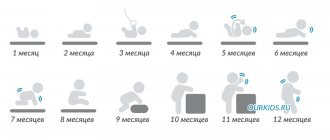Hemoglobin is a protein that contains iron and carries oxygen from the lungs to the organs. A pathology in which the hemoglobin level falls below normal is called anemia
Anemia is accompanied by weakness, headaches, tinnitus, decreased appetite and sleep disturbances. The most vulnerable category of patients with anemia are children of early and school age. Schoolchildren get tired quickly, learn more slowly and remember less information, do not get enough sleep and become irritable. With severe anemia, dystrophic changes occur in the heart muscle - this leads to disruption of the heart and circulatory failure.
Hemoglobin levels can be raised with medications and foods. However, the choice of treatment depends on the type of anemia and its cause. In this article we will answer the questions: what is the norm for hemoglobin in children, why does it decrease, what foods does it contain, and how to prevent anemia in children.
Hemoglobin - what is the norm for a child
Each blood indicator has a norm, including hemoglobin. The World Health Organization gives the following hemoglobin standards for children:
- newborns up to 2 weeks of life - not lower than 150 g/l;
- children from 2 to 4 weeks of life - 120 g/l and above;
- children aged 6 to 59 months - 110-140 g/l;
- children aged 5 to 11 years - 115-140 g/l;
- children aged 12 to 14 years - 120-150 g/l;
- children and adults over 15 years old - 130-160 g/l.
Anything below is considered mild (below normal, but above 90 g/l), moderate (70-90 g/l) or severe (below 70 g/l) anemia. Each of the three degrees of severity has its own symptoms and treatment tactics.
Hemoglobin norm for children over 12 years old
Hemoglobin (Hb) is a complex protein that is part of red blood cells. Its main task is to transport oxygen to all tissues and organs. A normal level of Hb in the blood is necessary for the coordinated functioning of the whole body. For children under 12 years of age, the normal hemoglobin level is the same for boys and girls. After 12 years, gender makes its own adjustments to the blood test. Therefore, the norm for boys and girls in adolescence is different.
| Age period | Hb norm for boys (g/l) | Hb norm for girls (g/l) |
| 12-14 years old | 120-160 | 115-150 |
| 15-18 years old | 122-163 | 117-153 |
After age 18, Hb levels for healthy men and women remain stable until age 65.
Why does a child have low hemoglobin?
Reasons for decreased hemoglobin levels in children: blood loss, insufficient blood production in the bone marrow and increased destruction of red blood cells.
Causes of low hemoglobin levels:
- malignant (cancerous) tumors;
- anemia due to vitamin deficiency;
- Iron-deficiency anemia;
- aplastic anemia;
- cirrhosis of the liver;
- Hodgkin's lymphoma;
- hypothyroidism;
- chronic kidney disease.
The first reason is blood loss. It can be acute and chronic. Typically, hemoglobin levels decrease several hours after the onset of blood loss. Chronic blood loss leads to anemia when the body does not have enough iron to produce new red blood cells. Examples of blood loss: gastrointestinal bleeding from an ulcer, bowel or kidney cancer, bone fractures, recent surgery, heavy menstruation in teenage girls.
The second reason is low blood production (erythropoiesis deficiency). In this case, a decrease in hemoglobin levels is caused by infections, hereditary pathologies, kidney diseases, copper and folic acid deficiency, vitamin B1 deficiency and malabsorption.
In addition, insufficiency of erythropoiesis occurs in myelofibrosis and osteomyelosclerosis. Myelofibrosis is a pathology in which fibrous tissue gradually replaces hematopoietic tissue in the bone marrow. Osteomyelosclerosis is the replacement of connective tissue with hematopoietic tissue. These disorders usually occur in cancers: lymphoma, multiple myeloma, chronic myelogenous leukemia.
The third reason is increased destruction of red blood cells. Occurs with pathological enlargement of the spleen, taking certain medications (quinine, quinidine, penicillin, ticlopidine), hemolytic-uremic syndrome, Epstein-Barr viral infection (human herpes virus type 4), malaria, botulism, tetanus, congenital heart valve defects, spider bites , insufficient levels of phosphates in the blood.
Other reasons for low hemoglobin levels in the blood:
- inflammatory diseases of the small and large intestine;
- insufficient intake of iron into the child’s body;
- chronic kidney disease;
- prematurity of the child;
- late or early umbilical cord ligation;
- Giardiasis is a parasitic intestinal disease;
- Helicobacter pylori infection and atrophic gastritis.
There are groups and risk factors that can lead to low hemoglobin levels and the most common type of anemia, iron deficiency:
- if the child was born with low body weight;
- children born from multiple pregnancies;
- children who did not receive enough iron through breastfeeding and formula milk;
- children who often suffer from infectious diseases;
- children with allergies;
- malnutrition, poverty.
A decrease in hemoglobin levels is not always regarded as a pathology. Children, especially teenagers, need a lot of iron for their body development. Due to the rapid growth of the microelement, there may be a temporary lack of microelement, so the level of hemoglobin in the blood decreases. This is especially true for children and adolescents who are actively involved in sports. They may develop "athlete's anemia." By eating foods high in iron, the deficiency is eliminated.
Causes of low hemoglobin in a child
If a child has low hemoglobin, the reasons can be very different. One of the reasons why low hemoglobin may be detected in a child is the low resistance of the hematopoietic mechanism in children to the influence of various factors. Doctors often call the second reason the rapid growth of the body, which results in a lack of nutrients (the body consumes material for the construction of cells faster than it is supplied).
The answer to the question of why a child has low hemoglobin depends on many factors. Experts distinguish two types of anemia: internal and external. The causes of anemia of internal origin can be:
- hemolysis (destruction of red blood cells);
- abnormalities of hemoglobin synthesis;
- hereditary diseases of the hematopoietic organs;
- insufficient bone marrow development.
Anemia of external origin can be caused by:
- insufficient and monotonous nutrition;
- parasitic or infectious diseases;
- problems with the gastrointestinal tract;
- allergic, skin diseases (neurodermatitis, diathesis, etc.);
- lack of vitamins in the diet, especially folic acid and vitamin C;
- lack of fresh air and low physical activity.
In some cases, the causes of low hemoglobin in children are a difficult pregnancy or illnesses of the mother during gestation: placental abruption, bleeding, threat of miscarriage, infectious diseases. If a mother is diagnosed with anemia during pregnancy, there is a high probability that the baby will be born with anemia. Low-quality or inadequate maternal nutrition can lead to such consequences. Low hemoglobin levels are especially common in children of vegans, since iron from plant foods is less absorbed than from animal products.
How does low hemoglobin manifest?
Signs of low hemoglobin levels manifest themselves in different ways. They can be divided into groups of symptoms: asthenic, epithelial, cardiovascular, muscular and secondary immunodeficiency syndrome.
Asthenic symptoms are manifested by increased fatigue, irritability, emotional instability, lethargy, and absent-mindedness. Children sleep poorly, eat little or do not want to eat at all. Children may complain of tinnitus, dizziness and headaches.
Epithelial symptoms: children have a pale face, areas of the legs and nails, pale ears and oral mucosa. The skin is dry and often flakes. Hair becomes brittle and may fall out. “Sticks” appear in the corners of the mouth. The child may complain of a burning tongue and dry mouth, difficulty swallowing and nausea.
Cardiovascular symptoms: increased heart rate, rarely shortness of breath. Sometimes the child complains of pain in the heart area.
Muscle symptoms: muscles weaken, the child quickly gets tired of simple activities, and may involuntarily defecate day and night due to weakness of the sphincter muscle.
Secondary immunodeficiency syndrome is manifested by the fact that the child often suffers from colds. He often experiences otitis media, pneumonia and intestinal infections. Rare symptoms of low hemoglobin levels are an increase in body temperature to 38 0C, red-tinged urine, swelling on the face.
Low hemoglobin - what to do
If you notice any of the symptoms described above in your child, contact your pediatrician. He will examine the child, listen to heart sounds, and give a referral for a general and biochemical blood test, which can confirm a reduced hemoglobin level. After the doctor has diagnosed anemia and identified its cause, the child is prescribed treatment and diet.
Depending on the cause of anemia, the doctor prescribes different treatments. For example, in case of deficiency anemia (when the body does not receive enough nutrients), medications are prescribed to compensate for the deficiency: B vitamins or iron supplements. For B12-deficiency anemia, the doctor prescribes vitamin B12 (cyanocobalamin), and in severe cases, a transfusion of red blood cells is indicated. For anemia of a chronic disease, iron supplements and recombinant erythropoietin are prescribed.
Often, anemic syndrome manifests itself in other diseases, for example, with kidney pathology, infections or disorders of the gastrointestinal tract. In this case, the doctor prescribes treatment for the underlying disease, which will restore the level of hemoglobin in the blood.
How to normalize hemoglobin
Therapy is carried out after recording changes in the level of hemoglobin in the blood and identifying the causes that led to the pathological condition. As a rule, treatment is carried out by a pediatric hematologist or pediatrician (therapist). In some cases, consultation with an endocrinologist, cardiologist, or neurologist will be required.
Treatment of high rates
If the Hb level is not critical and a short-term change is observed, then specific therapy is not required. To restore a slight increase, you need to drink more clean water and eliminate foods high in iron and folic acid from your diet. These include:
- red meat (especially liver);
- offal;
- buckwheat grain;
- any baked goods;
- nuts;
- red berries and fruits;
- alcohol.
In order to prevent thrombosis, you need to avoid foods high in cholesterol. Stop taking any vitamin complexes.
There are no specific medications to lower Hb. For preventive purposes, it is recommended to take blood thinning drugs - anticoagulants, antiplatelet agents. For example, Antithrombin, Heparin, Aspirin, Curantil. Only the attending physician should prescribe them and select the dosage regimen. Independent use threatens to develop undesirable consequences.
Treatment of low scores
Treatment tactics depend on the degree of hemoglobin reduction. If a decrease in protein in the blood of a teenager is caused by unbalanced or insufficient nutrition, then following a diet will be sufficient. Therapeutic nutrition to increase hemoglobin involves including the following products in the diet:
- beef liver;
- turkey;
- vegetables (beets, carrots, potatoes, spinach);
- legumes, beans;
- buckwheat, oatmeal;
- cheese;
- hazelnuts;
- dried fruits;
- dried mushrooms;
- fermented milk products (low-fat);
- berries and fruits (bananas, apples, peaches, raspberries, pomegranates, apricots, grapes, plums).
If other factors lead to a deviation from the norm and the diet does not help, then the use of iron-containing drugs will be required. Popular medications that increase Hb:
- Maltofer;
- Sorbifer Durules;
- Totema;
- Hemobin;
- Ferrum Lek;
- Ferronate;
- Irovit.
Drug treatment for children should be carried out under the strict supervision of a specialist.
Foods that increase hemoglobin
Food can increase hemoglobin levels in iron deficiency anemia. For other types (dyshematopoietic, posthemorrhagic, hemolytic, B12-deficiency anemia), specific treatment with drugs, blood transfusions or surgery is required.
List of products that increase hemoglobin:
- tahini halva contains more than 50 mg of iron per 100 g of product. Halva also contains vitamins E, B, phosphorus, zinc and calcium. Some of these substances improve the absorption of iron in the digestive tract;
- meat products: beef, liver, tongue, rabbit, veal. The iron content in these products ranges from 5 to 30 mg per 100 g of product;
- dried mushrooms: they contain up to 30 mg of iron per 100 g of finished product;
- seafood: squid, shrimp, clams, caviar, scallops. They contain up to 30 mg of iron per 100 g of product;
- wheat bran contains up to 15 mg of iron per 100 g of product;
- seaweed contains up to 12 mg of iron per 100 g of product;
- beets - 30 mg of microelement per 100 g of product;
- pomegranate - up to 30 mg of iron per 100 g of product.
It is recommended to add foods enriched with cobalt and manganese to your daily diet: squid, tuna, cod, catfish, flounder, pike, oat bran, rice flour. These products help the absorption of iron and accelerate the production of hemoglobin. It is also recommended to add medicinal herbs to food: stinging nettle, tripartite string, infusion of rose hips, strawberries, rowan tea, black currants.











